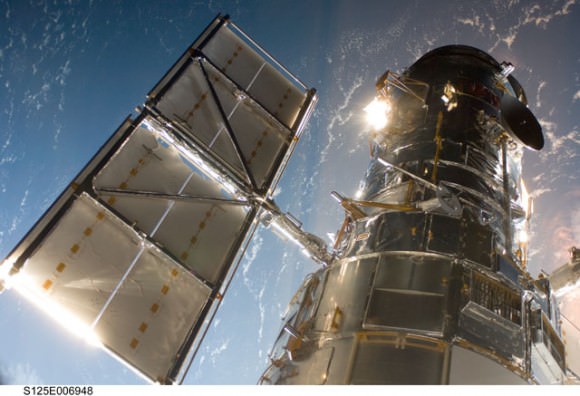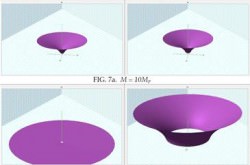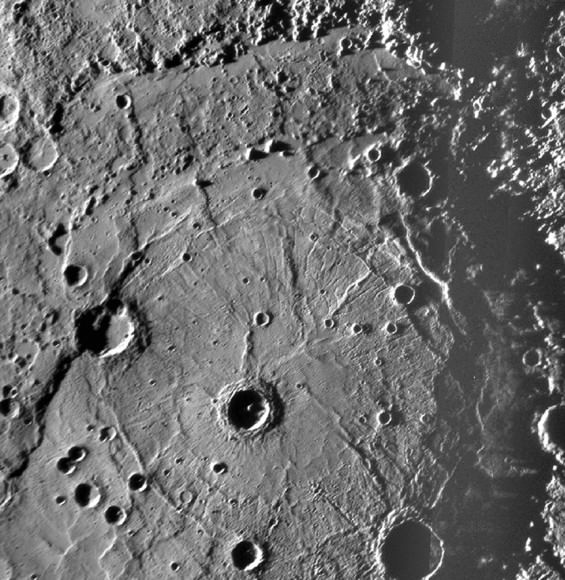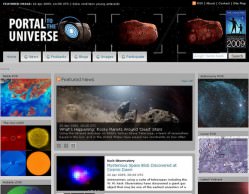Hubble Servicing Mission 4 in Pictures, Part 1

The long-awaited Servicing Mission 4 for the Hubble Space Telescope has provided drama, nail-biting excitement, fist-pumping triumphs and ‘what else could go wrong now’ moments. But the best way to to describe the mission is to let the amazing images from the EVAs do the talking. Below are high-resolution images from NASA, highlighting the first three spacewalks.
(...)
Read the rest of Hubble Servicing Mission 4 in Pictures, Part 1 (793 words)
M94 - The “Cat’s Eye” Galaxy by Roth Ritter
About 13 million light-years away in the constellations Canes Venatici, there’s a cloud. No, it’s not the same clouds that most of us have been experiencing lately - but a cluster of galaxies which appear form a single large cloud-like structure. The one we’re focusing on is Canes Venatici I, just a small section of the Virgo Supercluster and just moving along with the expansion of the Universe. In it we see a galaxy that stands out from the crowd for a very good reason… it has very little or no dark matter. It’s name? Messier 94. (...)
Read the rest of M94 - The “Cat’s Eye” Galaxy by Roth Ritter (1,212 words)
Is Everything Made of Mini Black Holes?

In 1971 physicist Stephen Hawking suggested that there might be “mini” black holes all around us that were created by the Big Bang. The violence of the rapid expansion following the beginning of the Universe could have squeezed concentrations of matter to form miniscule black holes, so small they can’t even be seen in a regular microscope. But what if these mini black holes were everywhere, and in fact, what if they make up the fabric of the universe? A new paper from two researchers in California proposes this idea.
(...)
Read the rest of Is Everything Made of Mini Black Holes? (422 words)
Amazing Images of Shuttle and Hubble Transiting Sun

No, these aren’t sunspots finally appearing on our currently quiet sun. Check out these great images taken by NASA photographer Thierry Legault. The “spots” are actually the space shuttle Atlantis and the Hubble Space Telescope transiting across the sun! Legault’s website says these are the only images ever taken of a transit of a shuttle and the HST in front of the Sun. Legault was in Florida at the time he took this image, about 100 km south of the Kennedy Space Center on May 13th 2009 12:17 local time, several minutes before grapple of Hubble by Atlantis. The transit only lasted .8 seconds, and Legault was able to snap 4 images a second, getting a total of 16 different shots of the entire event (he started shooting 2 seconds before the predicted transit.)
He took another image the previous day of just the shuttle transiting (see below.)
(...)
Read the rest of Amazing Images of Shuttle and Hubble Transiting Sun (104 words)
NASA Science News for May 15, 2009
Have you ever wondered how you'd make your morning coffee if you were living on another planet? NASA engineers have power systems on the drawing board that could run coffee makers--and so much more--on the Moon, Mars and beyond.
FULL STORY at
http://science.nasa.gov/headlines/y2009/15may_stirling.htm?list1035898
NASA Science News for May 11, 2009
After a smooth countdown and picture-perfect liftoff, space shuttle Atlantis and a crew of seven astronauts are in space, ready to begin their 11-day mission to service NASA's Hubble Space Telescope. Atlantis lifted off Launch Pad 39A at NASA's Kennedy Space Center in Florida at 2:01 p.m. EDT on May 11th.
FULL STORY at
http://science.nasa.gov/headlines/y2009/11may_hubblemission1.htm?list1035898
NASA Science News for May 6, 2009
NASA-supported researchers have figured out why Salmonella bacteria become more virulent when they travel on board spaceships. They've also learned how to calm the bacteria down again--a trick that could come in handy for fighting diseases here on Earth.
FULL STORY at
http://science.nasa.gov/headlines/y2009/06may_salmonella.htm?list1035898
Weekend SkyWatcher’s Forecast - May 1-3, 2009
 Greetings, fellow StarGazers! Let’s start the weekend off right by taking on a lunar club challenge and then kicking back to enjoy yet another spring meteor shower! (After all, if April showers bring May flowers, you do know what May flowers bring, don’t you? That’s right… Pilgrims!) Now that I’ve got you at least smiling, take out your binoculars, too… Because there’s two asteroids that are ripe for plucking - Hebe and Ceres. If you feel like being a little more serious about your lunar studies, why not do a little photographic map work? Just match the picture to what you see in the eyepiece and log your studies! Are you ready? Then I’ll see you in the back yard… (...)
Greetings, fellow StarGazers! Let’s start the weekend off right by taking on a lunar club challenge and then kicking back to enjoy yet another spring meteor shower! (After all, if April showers bring May flowers, you do know what May flowers bring, don’t you? That’s right… Pilgrims!) Now that I’ve got you at least smiling, take out your binoculars, too… Because there’s two asteroids that are ripe for plucking - Hebe and Ceres. If you feel like being a little more serious about your lunar studies, why not do a little photographic map work? Just match the picture to what you see in the eyepiece and log your studies! Are you ready? Then I’ll see you in the back yard… (...)
Read the rest of Weekend SkyWatcher’s Forecast - May 1-3, 2009 (845 words)
Starbursts from Dwarf Galaxies Like Fireworks

Fireworks in space? Astronomers are comparing “starbursts” from a galaxy that is in the throes of star formation to a Fourth of July fireworks display. And three particular galaxies are like my children’s favorite part of a fireworks display: the grand finale. These bursts occur at a fast and furious pace, lighting up a region for a short time before winking out. But that’s only part of the story. Archived data from the Hubble Space Telescope are showing that starbursts — intense regions of star formation — sweep across the whole galaxy and last 100 times longer than astronomers thought. The longer duration may affect how dwarf galaxies change over time, and therefore may shed light on galaxy evolution.
(...)
Read the rest of Starbursts from Dwarf Galaxies Like Fireworks (613 words)
New Mysteries Unveiled on Mercury

Even though Mercury looks like the Moon at first glance, scientists from the MESSENGER mission say it’s becoming apparent that Mercury is an amazingly dynamic planet, and is actually more like Mars. For example, before this mission, scientists weren’t sure if volcanism even existed on Mercury, but from the spacecraft’s two flybys, they now know it is a very important part of the planet’s history. Additional new findings from the second flyby of Mercury in October 2008 show that the planet’s atmosphere, magnetosphere, and geological past are all characterized by much greater levels of activity than scientists first suspected.
And by the way, isn’t this a stunning picture of an impact basin? It’s one of the new discoveries from MESSENGER.
(...)
Read the rest of New Mysteries Unveiled on Mercury (651 words)
Portal to the Universe Now Open
If you like RSS feeds, readers or other news aggregators, there’s a new website available that focuses on astronomy and space news. Called Portal to the Universe, it is the latest Cornerstone project of the International Year of Astronomy 2009 (IYA2009). Universe Today is one of the sites featured, and PTTU includes other news sites, blogs, video podcasts, audio podcasts, images, videos, and more. Don’t worry: PTTU isn’t trying to replace Universe Today or any other sites or blogs. The goal of this new site is to get the word out on what is being featured on all the different space and astronomy sites and push more readers their way. It’s all about community.
(...)
Read the rest of Portal to the Universe Now Open (211 words)
Latest from Saturn: Pastel Rings and Moons by the Bunch

The latest images from the Cassini spacecraft include this gorgeous natural color view of Saturn’s inner rings. Visible are the different degrees of transparency of the rings, which appear almost pastel in color. The dark shadows of the rings separate Saturn’s southern hemisphere in the bottom of the image from the north. The innermost D ring is invisible, laid over the planet’s northern hemisphere. The translucent C ring runs through the middle of the image. The denser B ring stretches across the top of the image. See below for more info on this image, as well as a challenge to “find the moons” on another Cassini image.
(...)
Read the rest of Latest from Saturn: Pastel Rings and Moons by the Bunch (260 words)
The Blurry Summit of Mars’ Pavonis Mons
This strange image was captured by the High Resolution Imaging Science Experiment (HiRISE) camera on board NASA’s Mars Reconnaissance Orbiter (MRO) on April 11th. At first it looked like a classic example of my early camera days without a tripod; most of the photos I took were blurry or out of focus (due to my less-than-perfect eyesight). So when I first saw this picture of the summit of one of the huge Martian ex-shield volcanoes, Pavonis Mons, I assumed it was a mistake; HiRISE either had the shakes or it had developed myopia.
Actually, this image is in focus, HiRISE is working perfectly. It’s the Martian surface that’s blurry…
(...)
Read the rest of The Blurry Summit of Mars’ Pavonis Mons (270 words)
Mars Express Spies Rocky, Chaotic Terrain on Mars
Wow – what a shot by Mars Express! Mars has several regions of what is called ‘chaotic terrain’. These are areas with large accumulations of rocks of varying sizes, as well as flat-topped features. These erratically shaped rocks are large, too: between 1-10 km in size. Some chaotic terrain on Mars is thought to form when there is a sudden removal of subsurface water or ice, causing the surface material to slump and break into blocks. The region shown here, however — Ariadnes Colles — is not a water-source region, so scientists are still debating whether Ariadnes Colles was formed by the action of water or wind. Either way, this is a very interesting region. See below for a straight on view that’s just as incredible.
(...)
Read the rest of Mars Express Spies Rocky, Chaotic Terrain on Mars (170 words)
Life Beyond Earth in 10 Years or Less?

Illustration credit: Robert McCall
Peter Smith feels pretty certain we’ll be finding life on Mars within the next decade.
Smith, the University of Arizona professor who led NASA’s Phoenix Mars Mission, made his predictions to a spellbound audience during a lecture at the University of Delaware earlier this month, and he discussed his ideas by phone on Thursday. He carries a “sense of optimism” about finding life on Mars, he said, because of the tantalizing clues Phoenix sent to Earth.
“Finding life on Mars would be one of the great discoveries of all time,” he said. “We’re not that far away. The next mission could be the one.”
(...)
Read the rest of Life Beyond Earth in 10 Years or Less? (593 words)



